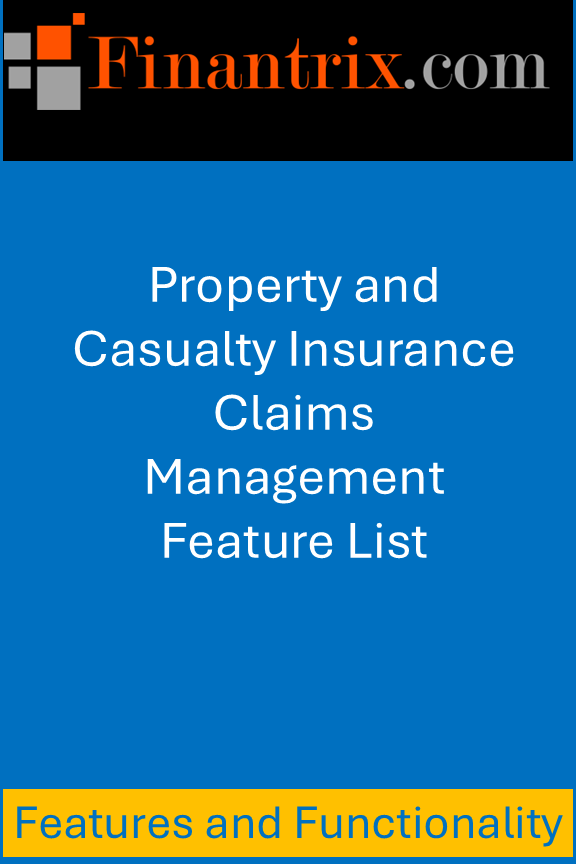Property and Casualty Insurance Claims Management Feature List
Price range: U.S. $299 through U.S. $599
Product Description

The Property and Casualty Insurance Claims Management Feature List document is a detailed, pre-built feature matrix for property and casualty insurance claims management software platforms. Delivered in an editable Word format, it outlines essential and advanced capabilities across claims intake, investigation, settlement, recovery, compliance, reporting, automation, and security. It serves as a practical tool to document requirements, prepare RFPs, evaluate vendor solutions, and benchmark internal systems, helping insurers plan or assess their claims technology initiatives.
This document presents a comprehensive feature list for property and casualty insurance claims management platforms, created as a practical, customizable tool for insurers, claims leaders, technology teams, consultants, and transformation projects. As the property and casualty insurance sector faces escalating pressures from regulatory changes, heightened policyholder expectations, climate-related risk volatility, and emerging digital threats, modernizing claims operations has become critical to both customer satisfaction and profitability.
However, clearly defining what a robust claims management system should deliver can be a complex process. Claims platforms must now move far beyond basic intake and payment processing. They are expected to handle the entire claim lifecycle with efficiency, transparency, and flexibility — from first notice of loss (FNOL) through investigation, adjudication, settlement, recovery, and closure, all while maintaining compliance and rigorous data security.
This feature list captures these needs across multiple functional areas. It begins with claims intake and registration, covering multi-channel submissions via portals, mobile apps, agents, call centers, email, and fax — along with automated FNOL acknowledgment, duplicate detection, document scanning, real-time policy verification, and comprehensive document management.
The platform must then support extensive investigation and analysis, including automated adjuster assignment, workload balancing, geolocation for field visits, mobile tools for adjusters, and AI-driven fraud detection and anomaly analysis. Integrated tools for damage estimation, virtual inspections, and collaboration with repair partners streamline assessments, while subrogation identification modules help maximize recoveries. Automated reserve management further ensures financial alignment.
A strong emphasis on workflow and process automation drives operational efficiency. This includes rule-based robotic process automation (RPA), customizable workflows, escalation protocols, process analytics for optimization, and integration with email, calendars, and legacy systems. Vendor and partner integration modules allow seamless collaboration with external service providers, streamlining repairs, assessments, and specialist consultations.
The platform must also support claims settlement and payment, offering interactive negotiation tools, automated payment processing, multiple disbursement channels, and secure integrations with accounting systems. Modules for recovery and salvage management, as well as final file review, compliance checks, and secure archival, complete the end-to-end process.
To meet both internal and external demands, the system needs robust reporting and compliance capabilities. This includes customizable dashboards, predictive analytics, benchmarking, automated compliance and regulatory reporting, fraud pattern analytics, quality assurance mechanisms, audit trail creation, and data privacy safeguards. Strong cybersecurity, incident monitoring, and compliance with data protection standards like GDPR and HIPAA are also essential.
By organizing these extensive requirements into a structured document, this feature list serves as a pre-built, editable toolkit that insurers can tailor to their unique business models, jurisdictional rules, and operational goals. It acts as a springboard for requirements workshops, detailed RFP creation, structured vendor evaluations, and benchmarking of existing systems. This ensures that no critical capability is overlooked, aligning cross-functional stakeholders and supporting informed, risk-mitigated decisions when selecting or enhancing a property and casualty claims platform.
Stipulations:
- As the Financial Advisor Workstation Features and Functions List is a digital product, it is sold as-is, and Finantrix will not accept any returns
- Depending on the size and complexity of your firm, the roles and responsibilities of advisors, some or all of the capabilities may not be relevant to you.
- Consultants, who may wish to use the deliverable at several clients, have different terms and price.
- Sold on an as-is basis and no warranties
- This sale does not include implementation help or support. If you need professional services assistance, please contact us.
- Please review our standard terms of service.
Got More Questions? Drop us a Line
Need Customization Help? Contact our Advisory Services
Property and Casualty Insurance Claims Management Feature List
Price range: U.S. $299 through U.S. $599

